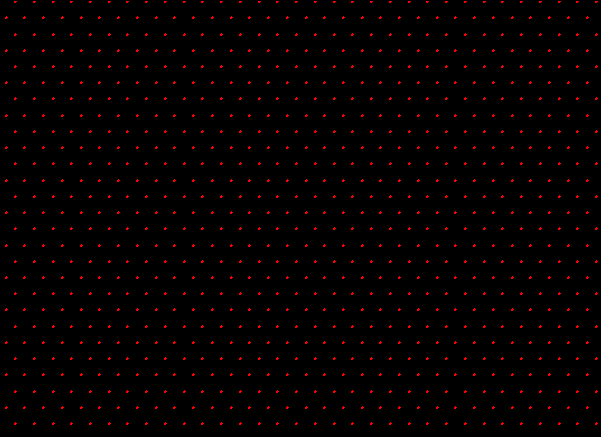 Figure 1. A triangular lattice of dots with animated locations for competing locations entering and vanishing from the picture. |
Hexagonal Hierarchies and Close Packing of the Plane:
Overview
A scatter of points, spread evenly
across
the plane, may take on a variety of configurations: two simple
regular
lattices involve points that suggest squares or equilateral
triangles.
If one wishes to consider circular buffers around each point, then
these
buffers may overlap or be widely spaced. A natural issue to
consider is to provide some sort of maximal coverage of the plane by
the
buffers: to provide a "close packing" of the plane by circles.
Gauss
(1831/40) proved that the densest lattice packing of the plane is the
one
based on the triangular lattice. In 1968 (and earlier),
Fejes-Toth
proved that that same packing is not only the densest lattice packing
of
the plane but is also the densest of all possible plane packings.
If one thinks, then, of the circles as if they were bubble foam, the
circles
centered on a square grid pattern expand and collide to form a grid of
squares (Boys). The circles centered on a triangular grid pattern
expand and collide to form a mesh of regular hexagons, like the cells
in
a slice of the honeycomb of bees (de Vries). The theoretical
issues
surrounding tiling in the plane are complex; even deeper are those
issues
involving packings in three dimensional space. The reader
interested
in probing this topic further is referred to the Bibliography at the
end
of this document. Interpretation of the simple triangular grid
has
range sufficient to fill this document and far more.
Classical Urban Hexagonal Hierarchies
One classical interpretation of what dots
on a lattice might represent is found in the geometry of "central place
theory" (Christaller, Lösch). This idea takes the complex human
process of urbanization and attempts to look at it in an abstract
theoretical
form in order to uncover any principles which might endure despite
changes
over time, situation, cultural tradition, and all the various human
elements
that are truly the hallmarks of urbanization. Simplicity helps to
reveal form: models are not precise representations of
reality.
They do, however, offer a way to look at some structural elements of
complexity.
Thus, dots on a triangular lattice are populated places (often,
villages).
Circles, expanding into hexagons, are areas that are tributary to the
populated
places. In the traditional formulation (described after Kolars
and
Nystuen) one considers four basic postulates (no one of which is "real"
but each of which is simple):
Suppose, in a triangular lattice of villages, that one village adds
to its retailing activities. After some time, growth occurs
elsewhere.
How might other villages compete to serve tributary areas: how
will
the larger, new villages share the tributary area? The answers
lead
to a surprising number of possible scenarios. Figure 1 shows the
first in an infinite number of possibilities. Animated locations,
for competing larger villages, are shown in Figure 1. The
smallest
villages are represented as small red dots; next nearest neighbors
competing
for intervening red dots are represented in blue; and, next nearest
neighbors
competing for intervening blue dots are represented in green. Of
course, one is usually only willing to travel so far to go to a place
only
slightly larger, so the fact that the animated pattern could be
extended
to an infinite number of levels, beyond green, may not mirror the
second
postulate. Over time, however, one might suppose further growth
and
an entire hierarchy of populated places.
 Figure 1. A triangular lattice of dots with animated locations for competing locations entering and vanishing from the picture. |
Virtual reality is an exciting form of
visualizing
three dimensional objects. Figure VR01 has a link on to a virtual
reality view of that figure: click on that figure to move into
the
virtual environment. Imagine the dots are holes in a pasta
machine
through which the pasta dough is to be extruded as spaghetti: the
view in Figure 1 is the template and the linked virtual reality is the
extruded pasta pulled through the red, blue, and green
holes.
Drive through this landscape; think of the view as a skyline of cell
towers
or some other tall thin structures (Arlinghaus, 1993). The
placement
of these towers is at vertices of equilateral triangles of various
sizes
forming an hexagonal hierarchy.
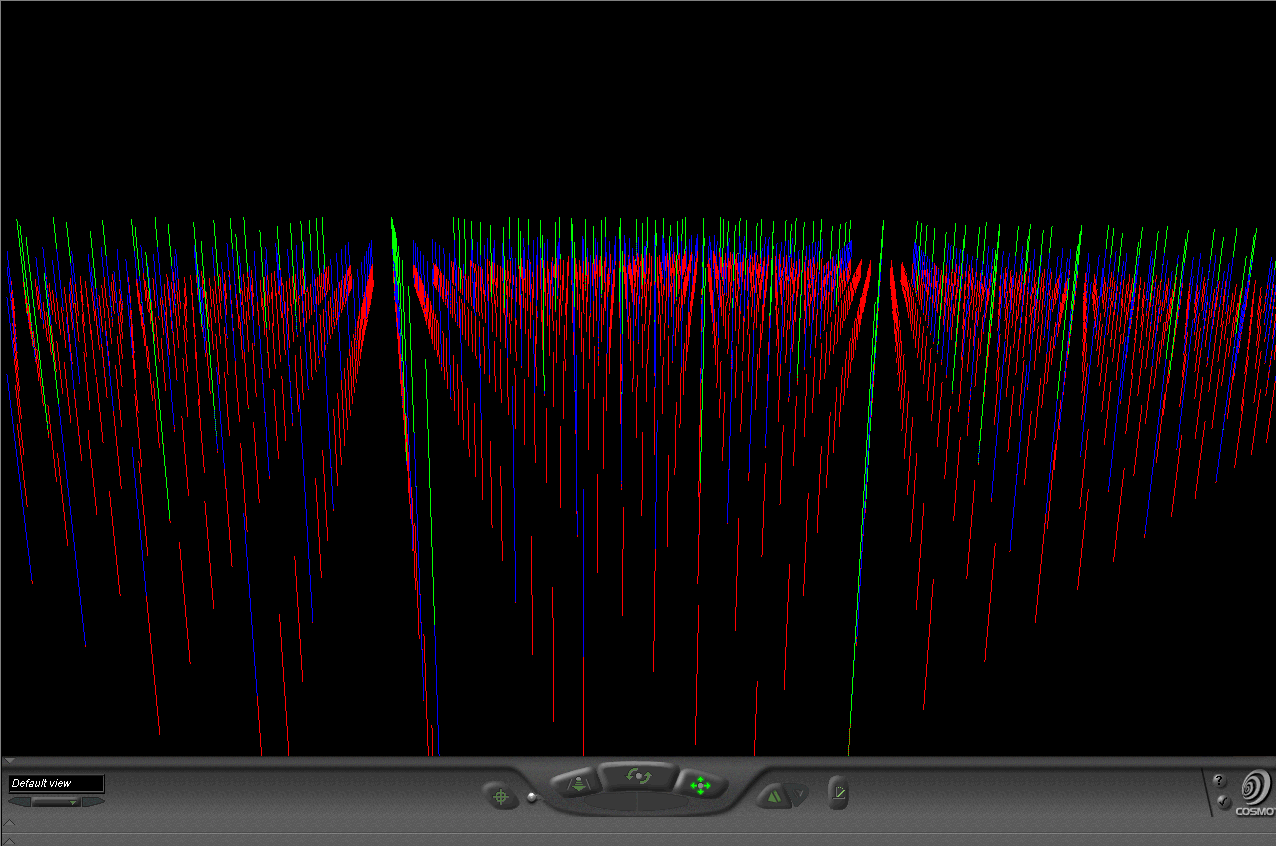 Figure VR01. A screen shot from the virtual world linked to this image. Click on the image to enter that world! |
The pattern in Figure 1 suggests one arrangement for villages, towns, and cities. We offer systematic visualization schemes for a variety of such arrangements: first, following the classical approaches to this issue found in the works of Walter Christaller and August Lösch and, second, following the contemporary approach presented in previous conventional publications by the authors of this submission.
CLASSICAL GEOMETRIC APPROACH TO HEXAGONAL HIERARCHIES
Visualization of Hexagonal Hierarchies using Animated Geometric
Figures
Marketing principle: K=3
Consider a central place point, A,
in a triangular lattice. Unit hexagons (fundamental cells)
surround
each of the points in the lattice and represent the small tributary
area
of each village (Figure 2). Growth at A has distinguished
it from other villages in the system. It will now serve a
tributary
area larger than will the unit hexagon. There are six villages directly
adjacent to A. The unit hexagons represent a partition of
area based on even sharing of area between A and these six
villages.
When A expands its central place activities, others may also
desire
to do so as well. Figure 2 shows the locations for the next
nearest
competitors to enter the system. Given that they, too, will share
area evenly, a set of larger hexagons emerges. Figure 3a shows
the
unit hexagons and the larger hexagons based on expansion of goods and
services.
The competitors that enter are spaced at a distance, in terms of
lattice
points spaced one unit apart, of ![]() units (Figure 2). The position of the competitors that enter the
system in this scenario are as close as possible to A;
expansion
of goods and services at any of the six closest neighbors would
constitute
no change in basic pattern. One might imagine, therefore, that
emphasis
on distance minimization optimizes marketing capability--distance to
market
is at a minimum.
units (Figure 2). The position of the competitors that enter the
system in this scenario are as close as possible to A;
expansion
of goods and services at any of the six closest neighbors would
constitute
no change in basic pattern. One might imagine, therefore, that
emphasis
on distance minimization optimizes marketing capability--distance to
market
is at a minimum.
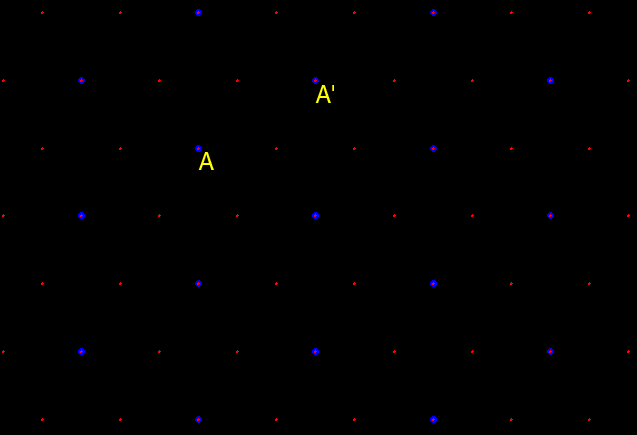 |
Figure 2. K=3: Marketing. Distance
measurement between adjacent competing new centers, A and A':
in this case, competing centers, blue dots, are spaced ![]() units apart, assuming a distance of one unit between adjacent red dots.
units apart, assuming a distance of one unit between adjacent red dots.
Thus, when competitors are chosen in this manner, the pattern of one
layer of hexagons, in relation to another, has become known as a
hierarchy
arranged according to a "marketing principle" (Figure 3a).
Notationally,
it is captured by the square of the distance between competing
centers:
as a "K=3" hierarchy (Figure 2). Each large hexagon
contains
the equivalent of three smaller hexagons. One large hexagon = 1
small
hexagon + six copies of 1/3 of a small hexagon = 3 small hexagons
(Figure
3b, c, and d). Thus, the value K=3 is not only related to
distance between competing centers but also to size of tributary areas
generated by competition: as a constant of the hierarchy.
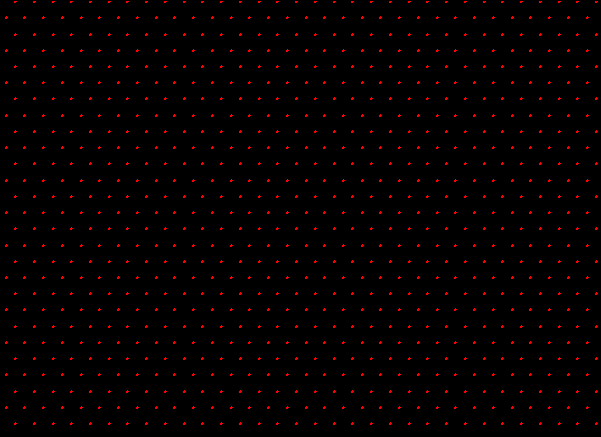 Figure 3a. K=3 hierarchy showing three layers of a nested hierarchy of hexagons of various sizes oriented with respect to one another according to the distance principle illustrated in Figure 2. |
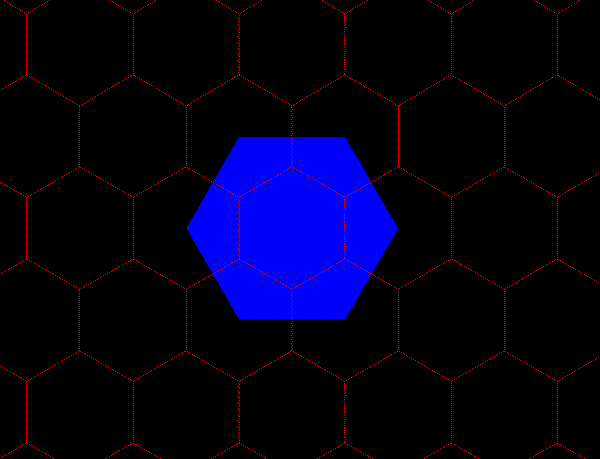 Figure 3b. Each blue hexagon contains the equivalent of three red hexagons: one entire red hexagon surrounded by six copies of 1/3 of a red hexagon. |
 Figure 3c. Each green hexagon contains the equivalent of three blue hexagons: one entire blue hexagon surrounded by six copies of 1/3 of a blue hexagon. |
 Figure 3d. The green hexagons contain the equivalent of 31 blue hexagons and 32 red hexagons. |
Figure 4 shows the locations for the next nearest competitors, next
beyond those from K=3, to enter the system. Given that
they,
too, will share area evenly, a set of even larger hexagons
emerges.
Figure 5a shows the unit hexagons and the larger hexagons based on
expansion
of goods and services. The competitors that enter are
spaced
at a distance, in terms of lattice points spaced one unit apart, of 2
units
(Figure 4). The position of the competitors that enter the system
in this scenario lie along radials that fan outward from A and
pass
along existing boundaries to tributary areas. One might imagine,
therefore, that emphasis on market penetration, or transportation, is
the
focus here.
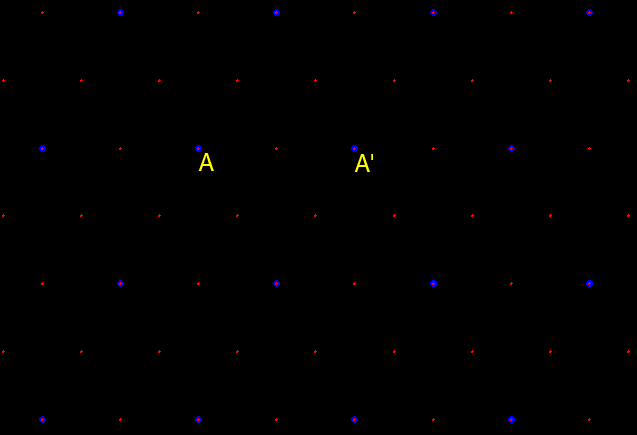 |
Figure 4. K=4: Transportation. Distance measurement between adjacent competing new centers, A and A' is 2 units, in this case (assuming a distance of 1 unit between adjacent red dots).
Thus, when competitors are chosen in this manner, the pattern of one
layer of hexagons, in relation to another, has become known as a
hierarchy
arranged according to a "transportation principle" (Figure 5a).
Notationally,
it is captured by the square of the distance between competing
centers:
as a "K=4" hierarchy (Figure 4). Each large hexagon
contains
the equivalent of four smaller hexagons. One large hexagon = 1
small
hexagon + six copies of 1/2 of a small hexagon = 4 small hexagons
(Figure
5b, c, d). Thus, the value K=4 is not only related to
distance
between competing centers but also to size of tributary areas generated
by competition--as a constant of the hierarchy.
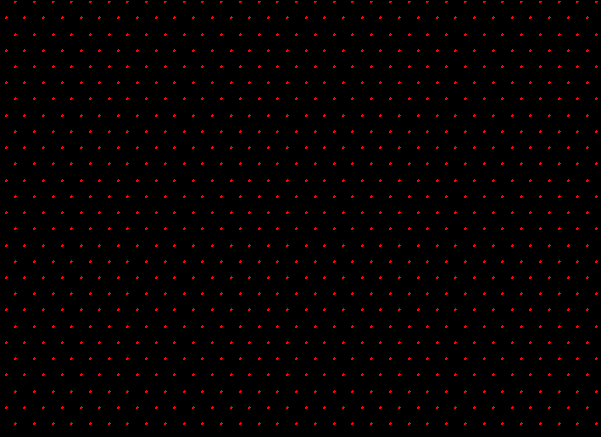 Figure 5a. K= 4 hierarchy showing three layers of a nested hierarchy of hexagons of various sizes oriented with respect to one another according to the distance principle illustrated in Figure 4. |
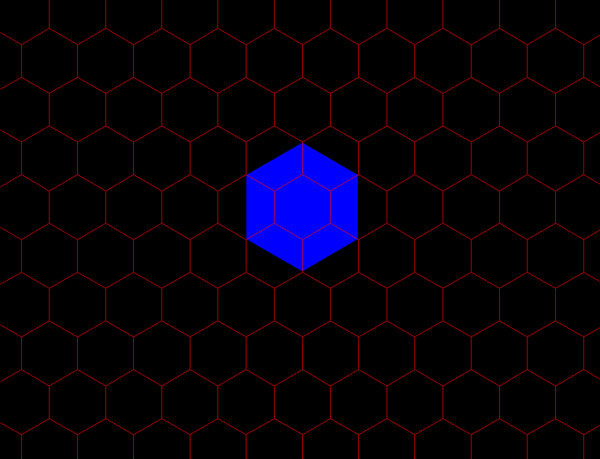 Figure 5b. Each blue hexagon contains the equivalent of four red hexagons: one entire red hexagon surrounded by six copies of 1/2 of a red hexagon. |
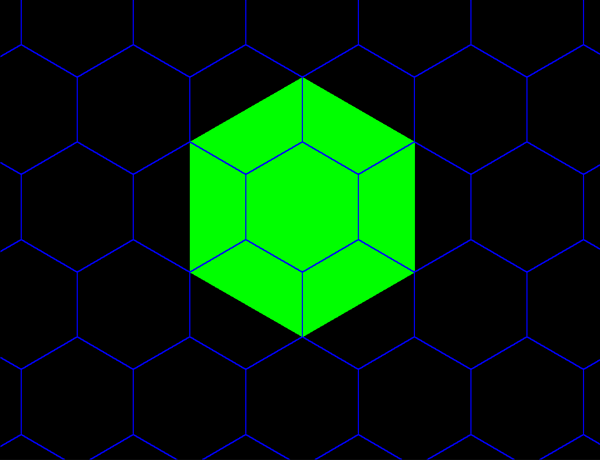 Figure 5c. Each green hexagon contains the equivalent of four blue hexagons: one entire blue hexagon surrounded by six copies of 1/2 of a blue hexagon. |
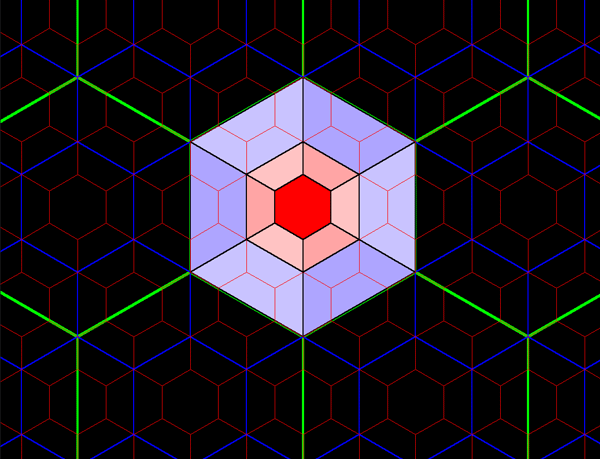 Figure 5d. The green hexagons contain the equivalent of 41 blue hexagons and 42 red hexagons. |
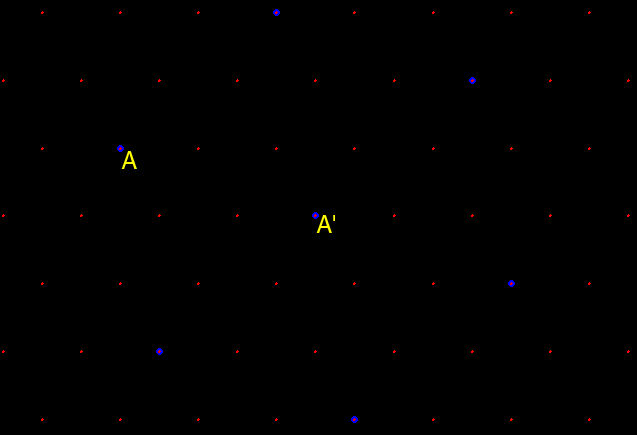 |
Figure 6. K=7: Administrative. Distance
measurement between adjacent competing new centers, A and A'
is ![]() (assuming a
distance of
1 unit between adjacent red dots).
(assuming a
distance of
1 unit between adjacent red dots).
Thus, when competitors are chosen in this manner, the pattern of one
layer of hexagons, in relation to another, has become known as a
hierarchy
arranged according to an "administration principle" (Figure 7a).
Notationally, it is captured by the square of the distance between
competing
centers: as a "K=7" hierarchy (Figure 6). Each large
hexagon contains the equivalent of seven smaller hexagons. One
large
hexagon = 1 small hexagon + six copies of a small hexagon (underfit and
overfit regions balance) = 7 small hexagons (Figure 7b, c, d).
Thus,
the value K=7 is not only related to distance between competing
centers but also to size of tributary areas generated by
competition--as
a constant of the hierarchy.
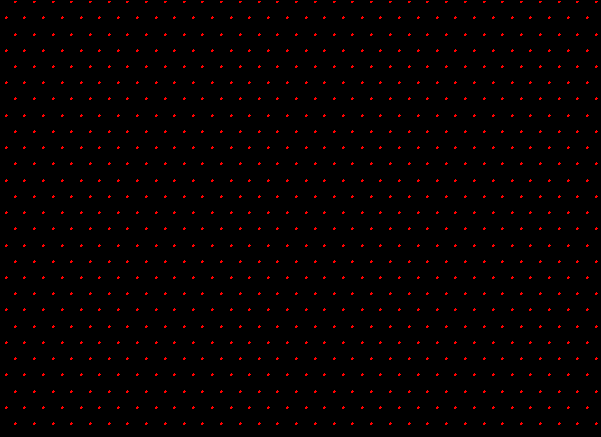 Figure 7a. K= 7 hierarchy showing three layers of a nested hierarchy of hexagons of various sizes oriented with respect to one another according to the distance principle illustrated in Figure 6. |
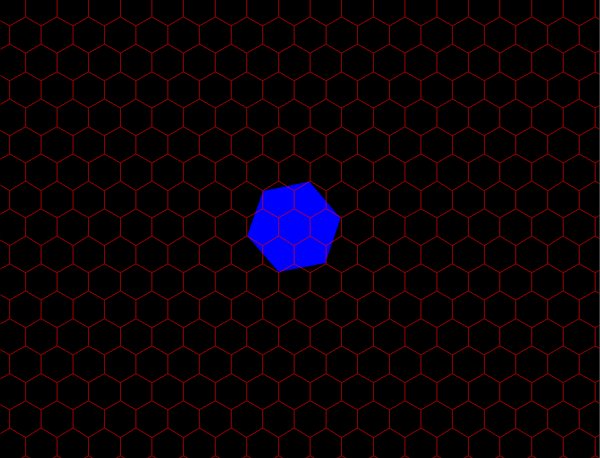 Figure 7b. Each blue hexagon contains the equivalent of seven red hexagons: one entire red hexagon surrounded by six copies equivalent to a single red hexagon. Each of the perimeter red hexagons is composed of 11/12 of a single red hexagonal cell plus 1/12 of an adjacent red cell: in an underfit/overfit pattern. |
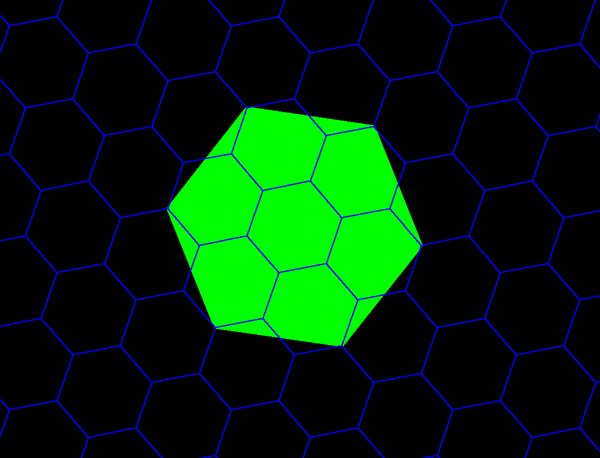 Figure 7c. Each green hexagon contains the equivalent of seven blue hexagons: one entire blue hexagon surrounded by six copies equivalent to a single blue hexagon. Each of the perimeter blue hexagons is composed of 11/12 of a single blue hexagonal cell plus 1/12 of an adjacent blue cell: in an underfit/overfit pattern. |
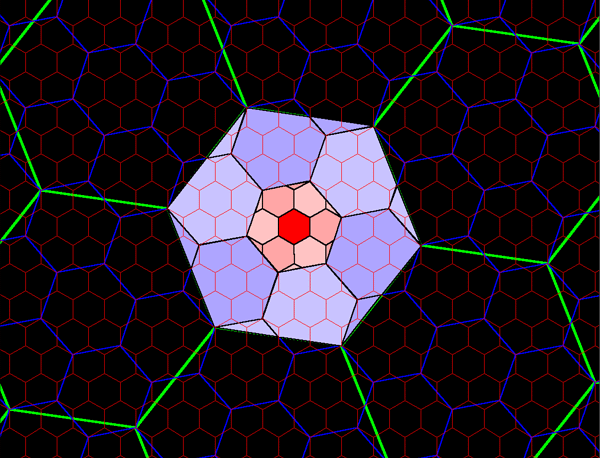 Figure 7d. The green hexagons contain the equivalent of 71 blue hexagons and 72 red hexagons. |
Visualization of Hexagonal Hierarchies using Mapplets
Another method of visualizing hexagonal hierarchies,
that is available only in current technology, looks simultaneously at
connection
patterns between multiple hierarchical layers of urban location maps
and
captures them as Java (TM) Applets: as "Mapplets." This
process
suggests a measure of visual stability of the geometric connectivity
pattern
that is related to the dimensions of the bounding box. Figures 8,
9, and 10 show Mapplets for the K=3, K=4, and K=7
hierarchies, respectively.
...ONLY in the original...see caveat at top of page...
Figure 8. K=3 Mapplet
Figure 9. K=4 Mapplet
Figure 10. K=7 Mapplet
Mapplets focus on connection patterns between successive hierarchical layers and, when K values are loaded as distances between hierarchies, they also suggest some elusive form of structural stability of geometric form. Animated maps of the central place geometry of the plane, coupled with mapplets showing animated hierarchical pattern alone, suggest a three dimensional view of central place geometry. A broader 3D view is suggested in the next section.
CONTEMPORARY GEOMETRIC APPROACH TO HEXAGONAL HIERARCHIES
Visualization of Hexagonal Hierarchies using Animated Geometric
Figures
and Virtual Reality
In the material below, we illustrate the use
of the fractal concept of self-similarity to generate hexagonal
hierarchies
equivalent to those above, We use a hexagon as an initiator, and apply
to it different selections of generators, to produce the different
hexagonal
hierarchies of classical central place theory (based on original
concept
and work of S. Arlinghaus). In the previous sections we formed
central
place hexagonal hierarchies by moving from small hexagons to large
ones;
here, we reverse the process and dissect, using the self-similarity
transformation,
a large hexagon to create the smaller ones. In both processes,
the
results correspond exactly. The art is in generator selection,
and
it is simply that art that is presented in this chapter. Later
work
delves into the mathematical foundations of that art.
The K=3 Hierarchy
When an hexagonal
initiator
is chosen and a two-sided generator, with included angle of 120
degrees,
is used to make successive replacement of the sides of the hexagon (as
in the animated Figure 11a), the outline of the next layer of the K=3
central place hierarchy is generated (the black lines in Figure 11a
suggest
interior connections). The replacement sequence applies the
generator
in an alternating pattern to the outside and then to the inside of the
initiator. When the original generator is scaled down, with shape
preserved, and applied in the outside/inside sequence to the newly
formed
blue polygon, the next lower level central place K=3 hierarchy
is
formed (as in the animated Figure 11b). The second, blue polygon
contains three scaled-down hexagons, self-similar to the first hexagon
(Figure 11a); the red polygon in the animation sequence contains three
shapes self-similar to the blue polygon (Figure 11b), and 27 (or 3
cubed)
hexagons self-similar to the original hexagon (Figure 11b). The
invariant
of 3, in the K=3 hierarchy, is replicated in this particular
fractal
iteration sequence.
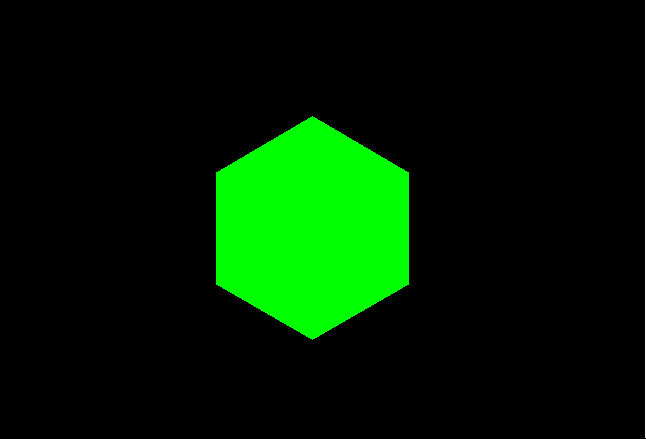
Figure 11a. Animated K=3 fractal iteration sequence: first transformation using a two-sided fractal generator applied successively to sides of the hexagonal initiator. |
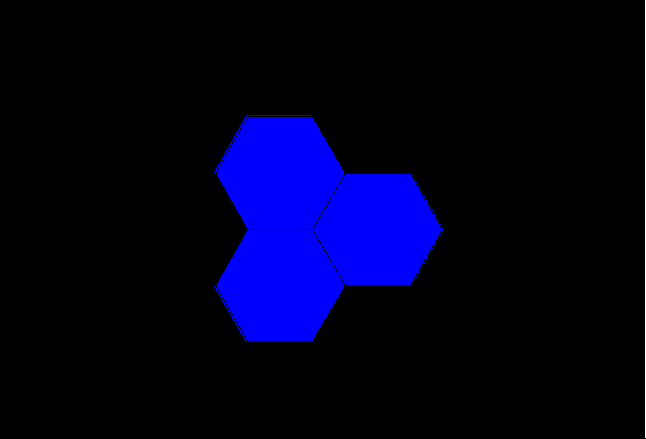 Figure 11b. Animated K=3 fractal iteration sequence: second transformation using a scaled-down two-sided fractal generator applied successively to sides of the blue polygon generated in Figure 11a. |
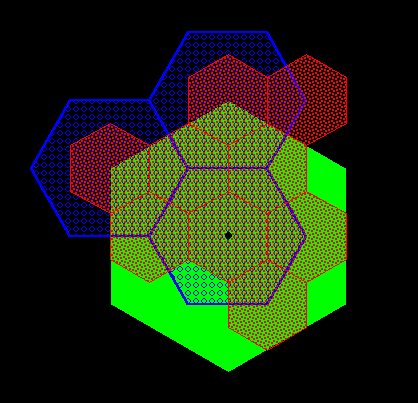 |
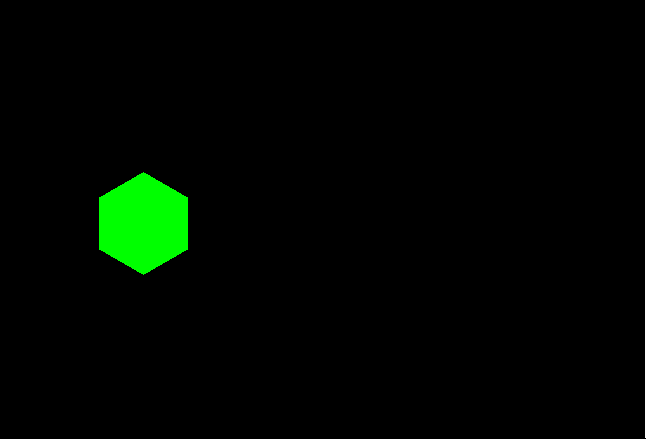 Figure 13a. Green layer on tile from Figure 12 fits exactly to tile the plane (Theorem of Gauss). |
 Figure 13b. Blue layer on tile from Figure 12 fits exactly to form classical K=3 landscape. |
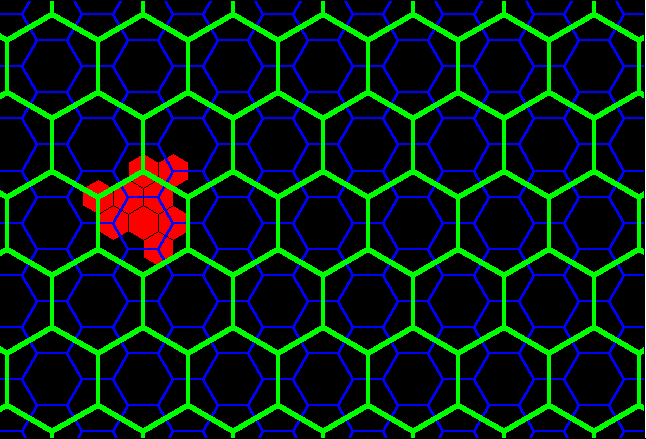 Figure 13. Red layer on tile from Figure 12 fits exactly to form classical K=3 landscape. Note, that for contrast in blocks, the red layer from Figure 12 is alternately colored in shades of yellow, also. |

Figure 14a. Animated K=4 fractal iteration sequence: first transformation using a three-sided fractal generator applied successively to sides of the hexagonal initiator. |
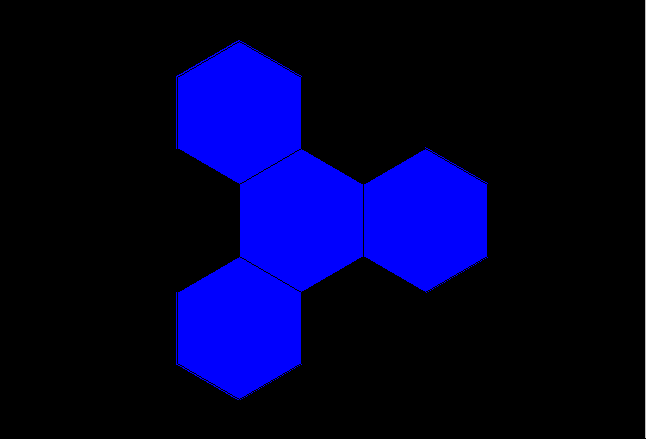
Figure 14b. Animated K=4 fractal iteration sequence: second transformation using a scaled-down three-sided fractal generator applied successively to sides of the blue polygon generated in Figure 14a. |
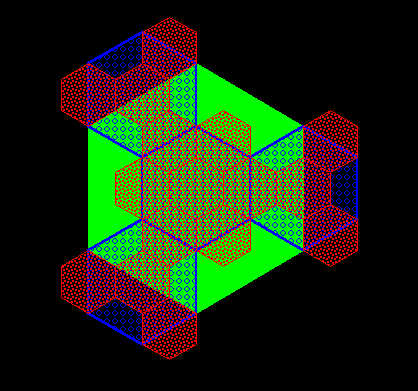 Figure 15. Fractally generated layers stacked on a single hexagonal tile. Click here to see a virtual solid model of the tile with which the reader can interact. Click here to see a virtual translucent model of the tile with which the reader can interact. |
Finally,
we tile the plane using the hexagonal initiators to discover if the
superimposed
structure also fits together perfectly (Figure 16). Hexagonal
tiles
are used to cover the plane without gaps, as is the case with the
sample
of green hexagons in Figure 16a. The hexagons mesh perfectly to
cover
the plane (Theorem of Gauss). In Figure 16b, the green outline of
the hexagons remains. Each of the solid green hexagons has had
the
fractal generator above applied and the consequent superimposed blue
tiles
come into view sequentially in this animation. Again, the fit is
exact, as we had hoped it might be. Finally, in Figure 16c, the
blue
outline only is retained from Figure 16b (along with the green outline
from Figure 16a). The final fractally generated layer derived
from
the blue polygons of Figure 16b comes into view in shades of red (or
yellow/gold
for contrast). The final layer of hexagonal base of unit hexagons
appears last. The fit is perfect: each green hexagon
contains
the equivalent of four blue hexagons and each blue hexagon contains the
equivalent of four red hexagons. The fractal generation procedure
created exactly the classical central place landscape of Figure
5. As the animation proceeds in Figure 16, further
layers
of the fractally generated hierarchy, attached to the tile in Figure
15,
come into view illustrating an exact meshing of tiles at all levels to
form a K=4 hierarchy.
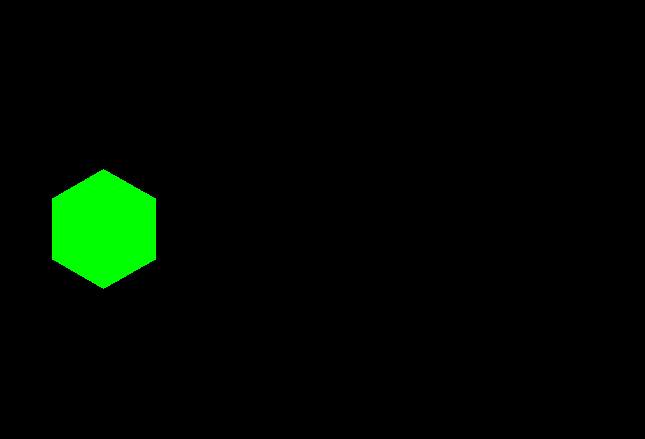 Figure 16a. Green layer on tile from Figure 15 fits exactly to tile the plane (Theorem of Gauss). |
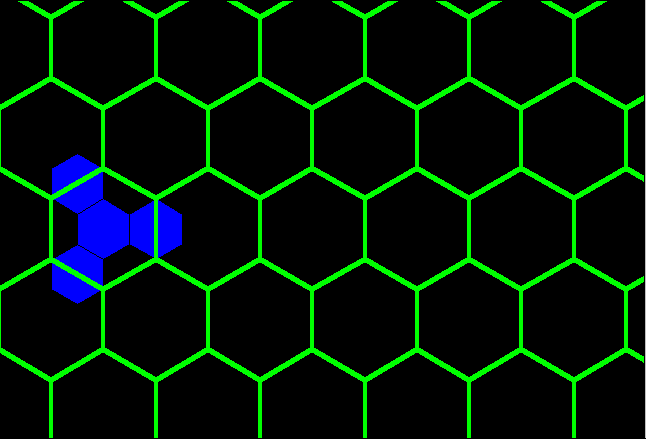 Figure 16b. Blue layer on tile from Figure 15 fits exactly to form classical K=4 landscape. |
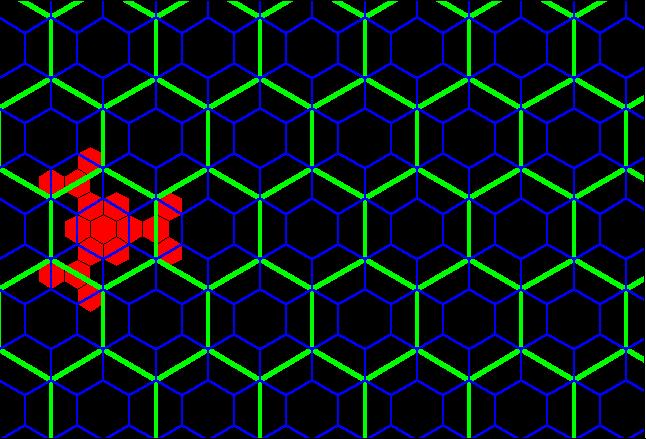 Figure 16c. Red layer on tile from Figure 15 fits exactly to form classical K=4 landscape. Note, that for contrast in blocks, the red layer from Figure 15 is alternately colored in shades of yellow, also. |
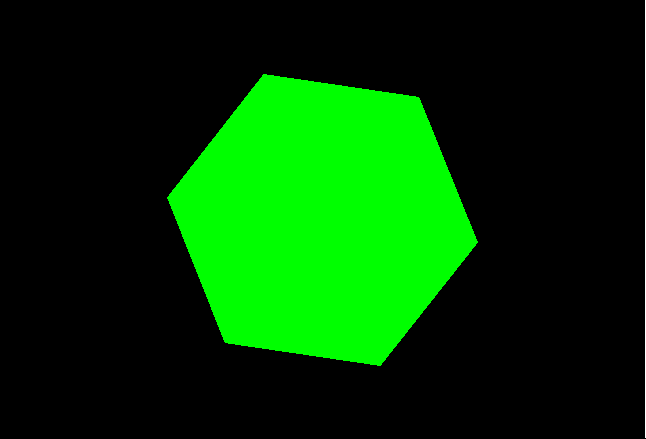
Figure 17a. Animated K=7 fractal iteration sequence: first transformation using a three-sided fractal generator applied successively to sides of the hexagonal initiator. |
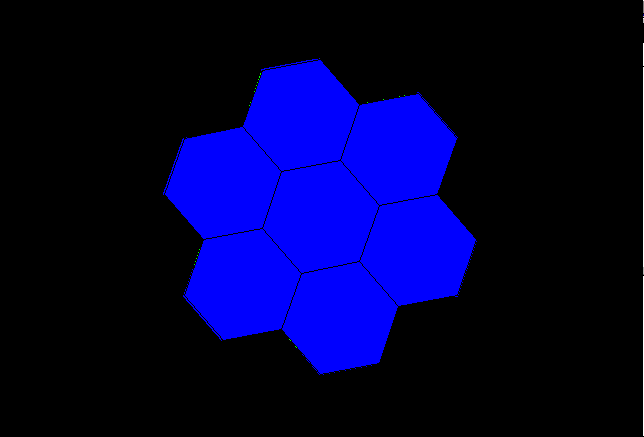 Figure 17b. Animated K=7 fractal iteration sequence: second transformation using a scaled-down three-sided fractal generator applied successively to sides of the blue polygon generated in Figure 17a. |
 Figure 18. Fractally generated layers stacked on a single hexagonal tile. Click here to see a virtual solid model of the tile with which the reader can interact. Click here to see a virtual translucent model of the tile with which the reader can interact. |
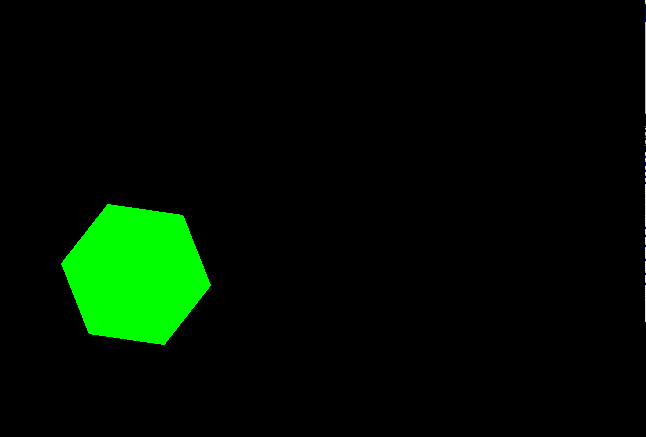 Figure 19a. Green layer on tile from Figure 18 fits exactly to tile the plane (Theorem of Gauss). |
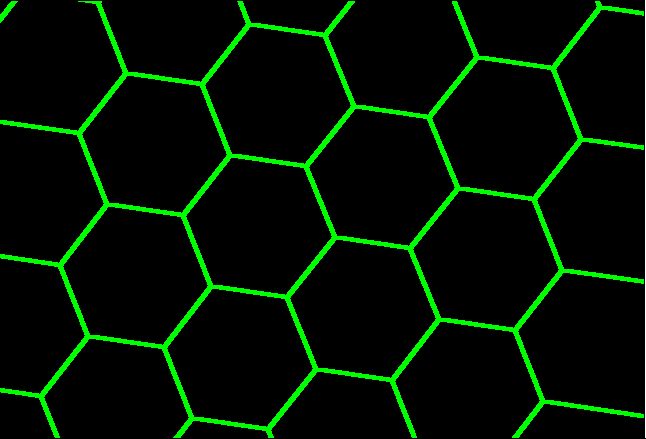 Figure 19b. Blue layer on tile from Figure 18 fits exactly to form classical K=7 landscape. |
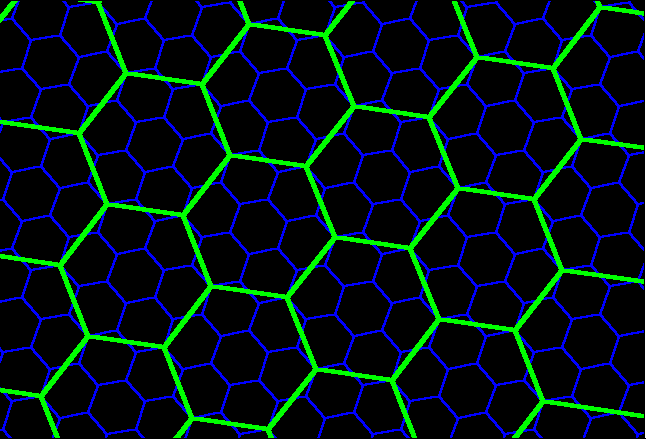 Figure 19c. Red layer on tile from Figure 18 fits exactly to form classical K=7 landscape. Note, that for contrast in blocks, the red layer from Figure 18 is alternately colored in shades of yellow, also. |
The Added Role of the Fractional Dimension
A fractal iteration sequence, such
as those above but carried out infinitely, might be thought to increase
the extent to which a line "fills" space. Both a single line
segment
and the letter "N" have Euclidean dimension 1; yet one of them fills
more
space than does the other. Mandelbrot (and others before him)
captures
this notion of space-filling with the concept of fractional dimension
(hence
"fractal"). He uses Hausdorff-Besicovitch dimension to measure
the
enduring mathematical concept of space-filling. We employ
Mandelbrot's
formulation for fractional dimension D as, D=log(number
of
generator sides)/log(square root of K). Thus, the
following
values for fractally-generated central place hierarchies emerge:
The idea with the space-filling is to pick an arbitrary point in the bounded space containing the curve. Place a circle of arbitrarily small radius around that point. Does that circle contain a point on the curve as the fractal iteration sequence goes to infinity? If that is the case for any point, then the curve is said to fill space and have dimension 2. If not, then there are holes or gaps (perhaps of infinitesimal size) in the space and the curve fails to fill space completely and has fractional dimension between 1 and 2 (as a sort of Swiss cheese, Emmenthaler, with holes). Thus, the K=4 fractal iteration sequence, if permitted to repeat infinitely, has the highest fractional dimension of these three: this curve gets "closer" to arbitrary points in space than do the lines of the other hierarchies, as one might hope a hierarchy interpreted as a "transportation" hierarchy would. The fractional dimension of the fractal iteration sequence corresponds to the intuitive notion of scholars over time as to interpretation: as another benchmark or field test of theory. The K=7 fractal iteration sequence, if permitted to repeat infinitely, has the lowest fractional dimension of these three, keeping control from the center optimized and hence supporting the "administrative" interpretation often given to the classical K=7 hierarchy. Finally, the K=3 falls between: marketing needs greater spatial penetration than does administration but less than does transportation. Here, the fit between classical interpretation and fractal calculation is reasonable (one could never say "exact" because the terms "marketing," "transportation," and "administrative" are inexact terms themselves).
- K=3, D=log2/log
= 1.2618595
- K=4, D=log3/log 2 = 1.5849625
- K=7, D=log3/log
= 1.1291501
What is difficult with fractals is to visualize
the
infinite process. Graphic color display, including three
dimensional
display, offers exciting strategies for visualization. Very
quickly,
however, it becomes difficult to draw the fine lines required by
repeating
the process at more and more local scales: lines have
width.
Electronic lines can be controlled and made finer than can pen lines,
but
eventually the line-width limits the capability to produce graphic
images.
Eventually, the mind's eye must take over and extrapolate the visual
infinite
process.
Another possibility might be to draw on the other
human senses to aid in that extrapolation. Thus, Figure 20 shows
figures generated by Fractal Music 1.9; click on the images and hear
the
associated music. The left figure shows the cellular automata base
generated
by default--it is bilaterally symmetric about a central vertical line
and
was generated using a symmetrically arranged initiator string of 64
digits
ranging in value from 0 to 7 (one for each tone). The next
figure,
K=3,
shows the cellular automata diagram (another sort of "bubble foam" in
appearance)
generated using the value for the fractional dimension of the K=3
hexagonal hierarchy carried out to 64 decimal places as the initiator
string
for the music. The next figure, K=4, shows the cellular
automata
diagram generated using the value for the fractional dimension of the K=4
hexagonal hierarchy carried out to 64 decimal places as the initiator
string
for the music. The final figure, K=7, shows the cellular
automata
diagram generated using the value for the fractional dimension of the K=7
hexagonal hierarchy carried out to 64 decimal places as the initiator
string
for the music. Click on each figure to hear the music. Each
musical sequence, of over 1000 steps, was created from the default
base,
changing only the initiator string, so that the fractional dimension is
what operates on a "seed" value of basic notes. The listener
should
hear the basic pattern in all characterizations: great symmetry
in
the base value; abrupt changes of state in the K=3 value; a
smoother
filling of musical space in the K=4 music; and, gaps in the K=7
musical characterization derived from the K=7 fractional
dimension.
Thus, we extend visualization from two dimensional graphical images to
three dimensional graphical images to the mind's eye, and finally, to
the
mind's ear: capturing hierarchical pattern through 1000 steps or
more is easy in the musical clips. Such characterization offers added
capability
to those of us with all of our senses that are functional: for
those
with limited visual sensory function, it offers a way to an auditory
"visualization"
of the beauty of geometry.
 Base |
 K=3 |
 K=4 |
 K=7 |
The complex mechanics of the theory behind hexagonal hierarchies come alive as a single dynamic system when visualized through the lens of fractal geometry. The fit of the classical and fractal geometric hierarchies is exact. Thus, as one might use a carefully surveyed topographic map, with field-checked spot elevations, as a guide into dense jungle or other unsurveyed landscapes, so too we use our carefully surveyed alignment of the classical and the fractal hexagonal hierarchies as a guide into unseen or unproven areas of geometry and geography. The difference is that the "field" tests in one case occur "terrestrial space" while in the other the "field" tests occur in "geometry, number theory, and pure mathematics."
In the material above, we saw hexagonal hierarchies, of different orientation, cell size, and stacking characteristics, arise from the same base of unit hexagons. These were associated with three integers: 3, 4, and 7. The thoughtful reader might naturally ask a number of questions, such as:
The result of Loeb/Dacey is important because it shows
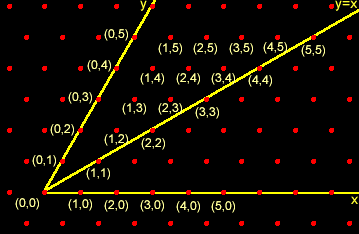 |
Previous published research by the authors of this presentation has
shown how to determine the number of sides in a fractal generator that
will generate a correct hierarchy for arbitrary K values and
how to determine fractal generator shape that will generate a correct
hierarchy for arbitrary K values. Work in progress shows
how
to extend the three dimensional and other visualization schemes shown
here
to higher K values. In it, we offer mathematical proof of
these ideas and extensions of them into new realms. The classical
is used for alignment of new with the old: a strategy useful in a
wide range of theoretical and applied research.